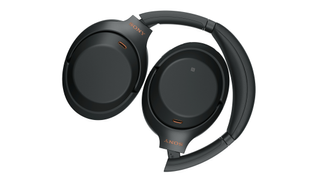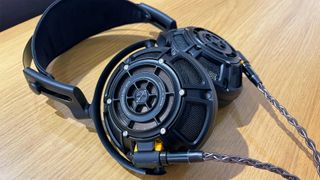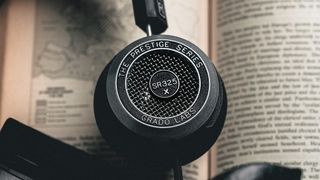Since the What Hi-Fi? Awards began in 1983, headphones have been annually celebrated by this publication – first in their wired form, of course, but now rightfully inclusive of wireless pairs too, as they continue to be the most personal and most intimate deliverers of music, not to mention facilitators of music on the move. In the past couple of decades, we’ve had some belters in both categories, from entry-level aces to high-end hotshots and including a model that has won a gong in more years than it hasn’t!
So, somewhat ashamedly, years after we have created lists for the best speakers, turntables and stereo amplifiers of this century, it is well and truly time to salute what are, in our books, the very best headphones of the past 23 years. Many have heritages dating back decades, but that doesn't necessarily mean they are lost to the annals of time. Most are still available today in newer editions, their legendary status kept alive for newer generations of music fans to discover, so it’s not too late to own a slice of headphone history yourself.
Grado SR80 (1991-)

The SR80 are special for three reasons. Firstly, they are what the legendary headphones maker considers its first-ever pair – built on the Grado family’s kitchen table in 1991, and the foundation on which it built its open-back headphones empire. Secondly, they have spawned many iterations over the three decades since as the model has evolved, also making them one of Grado’s longest-running pairs. And thirdly, they’re one of the – if not the – most celebrated headphones in the What Hi-Fi? Awards. That they continue to set the benchmark for entry-level wired headphones performance (with the SR80x), and probably will for years to come, makes them legends very few can claim to be.
Grado SR325 (1993-)

Another of these ‘very few’ legends does, in fact, belong not only to the same brand but to the very same headphone range. The flagship model in Grado’s Prestige series has also managed to resist bowing down to newer, better competition over the decades – and, no doubt a sticking point for many, has remained just as resilient in the design department as in the performance one. Indeed, Grado’s first metal headphone is still going strong 30 years down the line in the latest SR325x variant.
Sennheiser HD600 (1997-)

Fewer headphones are as legendary and respected as Sennheiser’s HD600, so it’s perhaps not surprising that, with nearly 30 of history, heritage and a load of critical acclaim behind it, you can still pick up a pair from Sennheiser’s website. Such sacred status is deserved. That the HD600 made our list of the best hi-fi of the 1990s (hi-fi as a whole, that is, not just headphones) tells you just how big of an impression they made on us. They had a wonderfully forgiving, smooth balance, yet delivered plenty of attack and drive when required. Detail levels were high, but despite all the analysis it was oh-so-easy to sit back and get lost in the music. And you could do so for hours thanks to a super-light, super-comfortable build. Subsequent models made gains in transparency and overall performance, but even today the HD600 headphones stand out as something special.
Bose QuietComfort (2000-)

One of the most iconic headphone models on this list, and not far behind AirPods and Beats as the most visually recognisable of all time, Bose’s QuietComfort over-ears have become synonymous with class-leading active noise cancellation. More than 30 years ago, Bose launched the first commercially available active noise-reduction headphones, powered either by NiCad batteries or the aircraft's cockpit, and designed exclusively to help pilots land planes. The company’s first consumer pair, the QuietComfort, launched several years later at the turn of the millennium and benefitted from this sound-blocking technology – and the rest is history. Fast forward to today, a good eight or so QC over-ear models later, and when you think of noise-cancelling, you still think of Bose.
Beyerdynamic T1 (2010-)

While the likes of Grado and Sennheiser all made exceptional headphones below the £1000/$1000 in the early noughties, if you asked many of us then which headphone at that level would please most people, it’d be the Beyerdynamic T1. (And it still would be today, in their third-gen guise.) The original arrived in 2010 as an underdog – just like any headphones did at the time in the shadow of the widely acclaimed Sennheiser HD 800 that arrived a year earlier. But it didn’t take long for the company’s new top-of-the-line pair to lead the pack. The first T1 claimed to be the first to break through the one-tesla barrier of magnetic induction (hence, ‘T’ is for ‘tesla’), with that high magnetic flux density a key reason for their class-leading dynamic expression, which was coupled with exceptional bass, resolution and control. Add super-comfy earpads, an open-back design not as leaky as others, and now, for the third-gens, wider compatibility with modern-day sources thanks to a switch from a 600-ohm impedance to just 32 ohms, and you have yourself a winner. A few words are repeated across our reviews of the model’s three consistent generations: nuance, control and comfort. That says it all really.
Shure SE425 (2010-)

Considering the SE425 in-ears won a What Hi-Fi? Award the year we heard them (2013) right up until they were ousted in 2020 – by a newer Shure model! – shows how securely Shure has had the mid-range wired earbud market wrapped up for most of the 21st century. The SE425 continued a running streak that very few are capable of, despite doing so in the dwindling years of the now-niche category, for one simple reason: they were, to quote our review, “fun, absorbing, classy, polished, captivating”. What more could you ask for? Honestly, a bit more punch in the bass wouldn’t have gone amiss, and those transparent housings have probably turned fewer passing heads than the average lampost in their lifetime, but those wishlist items paled into insignificance in light of how much else they delivered for your money next to almost a decade of competition.
AKG K550 (2012)

It’s no real surprise to see an AKG model in this list; the Austrian company enjoyed a prolific period of domination in the affordable on/over-ear headphones space throughout much of the noughties. One of its brightest stars was the K550, which won a handful of What Hi-Fi? Awards in a row for being the best home on-ear headphones below £200. They might’ve looked like a pair of construction worker’s ear defenders, but while they were big in size they were also big in sound, with an open, spacious sound that set the benchmark for neutrality and detail at their price level for years.
Sennheiser Momentum (2012)

No doubt about it, Sennheiser’s wired Momentum range – both its over-ear and in-ear models – helped popularise the portable headphone into how it looks today (minus the cable, natch). The first Momentums we heard went on to win a What Hi-Fi? Award in 2013 for their “refreshingly balanced sound”, which wasn’t as bass-heavy as other fashion-first ‘style headphones’ were producing at the time, while their sequel won four times as many before the blueprint was carried into a Bluetooth design. Indeed, that audiophile sound quality in an affordable and attractive-looking package was tough to beat. Including the multiple awards the Momentum in-ears scooped, you have to be looking at double figures for the family – one very full trophy cabinet in the Momentum household.
B&W P7 (2013)

The Sony WH-1000XM2-trumping P7 deserve a place on this list too. Bowers & Wilkins’ first ever pair of over-ear headphones (they followed the P3 and P5 on-ears) were worth every penny when they arrived in 2013, and deserved the What Hi-Fi? Award they won that year too, but they weren’t a case of ‘first time lucky’; the subsequent Series 2 smaller headphones and then the wireless versions also hugely impressed. In fact, across that distinct ‘P’ line of sleek, black-and-metal, collapsible and insightful headphones were many successes.
Shure KSE1500 (2015-)

How much? There are many a headphone model on this page with an asking price well into four figures, but somehow it seems disingenuous when attached to a pair of in-ears. Of course, that school of thought has everything to do with perceived value and, as we found out in 2016, very little to do with sonic value – because, yes, the £2900 / $3000 / AU$ 5500 KSE1500 are, would you believe, worth every dime. Like the Stax over-ears further down this page, the KSE1500 sport electrostatic driver technology and therefore come with a pocketable amplifier that is capable of higher voltages and necessary to drive them (which does, admittedly help the perceived value of this package). We didn’t just call them the best in-ears we’d heard but “among the finest headphones around, regardless of price or type”. But while the KSE1500 were the pioneering designs, their success actually led Shure to offer a more affordable KSE1200 model that simply forgoes the digital circuity in the amplifier (no big loss really), making them the better value option.
Sony MDR-Z1R (2016-)

“The best closed-back headphones we’ve heard” is quite the label to attach to a pair of headphones even if it does cost £1700 / $1800, but that’s how strongly we felt about these Sonys once they’d entered our test rooms fresh from their introduction at IFA show. With their low resonance enclosure made of Canadian softwood and water (yes, water), art-like grilles (their pattern is based on the Fibonacci sequence) and ultra-comfortable fit (just look at those earpads), the MDR-Z1R proved the complete package. While many pairs have crossed that threshold since, we still grab our MDR-Z1R sample any time we’re reviewing a new high-end model – seven years on, they’re still fantastic references.
Focal Utopia (2016-)

Focal’s history with headphones is much shorter than its history with loudspeakers, and yet that is arguably now where the French company’s legacy is most impressive. While Focal chose to first hone in on the portable headphone with its Spirit One in 2012, it was the launch of the Utopia four years later that revealed Focal’s true intentions and ambitions and paved the way for the brand to become a class leader in the high-end home market through subsequent open-back and closed-back designs. Those 2016 Utopia were “one of the finest headphones on the planet”... until a gently revamped variant came along in 2022, just to remind everyone they’re among the best money can buy.
Sony WH-1000XM (2016-)

Even if Sony’s WH legacy ended tomorrow, the model would still make this list for its dominance over the past six or seven years, when the wireless over-ear competition has arguably been as rife as it’s ever been. The first model scooped a What Hi-Fi? Award in 2016 (not long after we began including Bluetooth pairs in our Awards season), and save for the following year when the B&W P7 trumped the MK2 Sonys, one of its successors has taken home the crown ever since. Domination or what?
Stax SR-L700Mk2/SRM-700T (2019-)

A definitive headphones round-up without Stax would be like a list of the best Tarantino movies without Reservoir Dogs, and we aren’t about to make that unforgivable error. Our pick of the iconic electrostatics is actually the most recent model we have reviewed, the SR-L700Mk2 (among the latest models in the SR-Lambda series that dates back to the ‘70s) with the partnering SRM-700T energiser that drives them (there’s also an alternative SRM-700S which substitutes the 700T’s valves for JFETs in the output stage). Indeed, 83 years and counting since the renowned Japanese company launched the world’s first electrostatic headphones, Stax’s ‘earspeakers’, as it likes to call them, are still going strong. And it’s easy to see why when the SR-L700Mk2’s unnervingly clear and astonishingly detailed soundstage has us reaching for praise as high as “breathtaking” and “little short of magical”.
Apple AirPods Max (2020-)

Arriving after what felt like years of rumours, Apple’s first pair of over-ear headphones were pretty much what we expected – wireless, noise cancelling, utterly unique in some ways and, yes, expensive. But we didn’t expect them to sound quite so good. We knew Apple was capable of sonic brilliance, of course, but the AirPods earbuds hadn’t been as sonically competitive as we’d have liked them to be at that point, and could any wireless performance really justify being twice the price of the current premium competition? The AirPods Max answered that with a big fat ‘yes’, setting a new sonic benchmark and opening the gates for a new higher-priced segment of the market to emerge. A milestone in the history of wireless headphones, without question.
Yamaha YH-5000SE (2022-)

You might think it premature to include a headphone that has only just hatched in a ‘best of’ list like this, but the YH-5000SE is no ordinary headphone and we’re confident its success will be enduring. After all, headphones of this calibre don’t come around very often – in Yamaha’s case, it took a special tribute to a landmark 50-year-old design and six years of development (in which the engineering team tested more than 1000 driver diaphragms). They completely redesigned the Orthodynamic diaphragm (planar magnetic) driver from the 1976 HP-1 for this new flagship model, and the results are spectacular. The YH-5000SE are arguably the finest, most revealing pair of headphones we’ve come across.
MORE:
See our current crop of What Hi-Fi? Award winners
Closed-back vs open-back headphones: which one is best for you?

